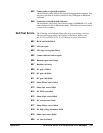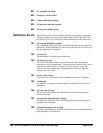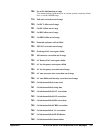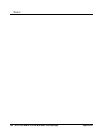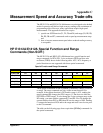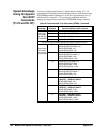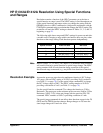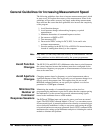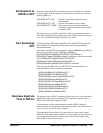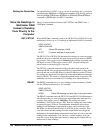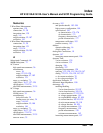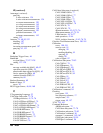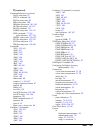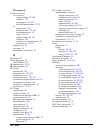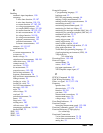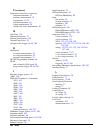
Measurement Speed and Accuracy Trade-offs 197Appendix C
Set Autozero to
ONCE or OFF
Autozero causes the A/D to alternately measure its internal zero and the
external signal. Autozero improves reading accuracy; however, it reduces
reading speed by ½.
CAL:ZERO:AUTO ON ----The zero will be measured before each
measurement.
CAL:ZERO:AUTO OFF ----No new zero readings will be made.
CAL:ZERO:AUTO ONCE----Does one Autozero operation when the
command is received and also sets the mode
to autozero OFF.
The zero may vary over time, especially as the room temperature varies.
Noticeable changes can be expected over many minutes or hours. However,
over a few seconds the changes should be very small.
Turn Autorange
OFF
Turning autorange OFF makes the HP E1312A and HP E1412A take all
measurements on a fixed range which results in fast and predictable
measurement times.
Autorange is turned
OFF when a numeric value or MIN|MAX is specified for
the <range> parameter of the
CONFigure, MEASure,
[SENSe:]RESistance:RANGe, [SENSe:]VOLTage:RANGe, or
[SENSe:]VOLTage:AC:RANGe command. Autorange is directly controlled
by the
[SENSe:]VOLTage:RANGe:AUTO ON|OFF,
[SENSe:]VOLTage:AC:RANGe:AUTO ON|OFF, or
[SENSe:]RESistance:RANGe:AUTO ON|OFF command.
You can query the HP E1312A or HP E1412A autorange status for a
particular function by the following commands:
[SENSe:]CURRent[:DC]:RANGe:AUTO?
[SENSe:]CURRent:AC:RANGe:AUTO?
[SENSe:]FREQuency:VOLTage:RANGe:AUTO?
[SENSe:]FRESistance:RANGe:AUTO?
[SENSe:]PERiod:VOLTage:RANGe:AUTO?
[SENSe:]RESistance:RANGe:AUTO?
[SENSe:]VOLTage[:DC]:RANGe:AUTO?
[SENSe:]VOLTage:AC:RANGe:AUTO?
[SENSe:]RESistance:RANGe:AUTO?
Decrease Aperture
Time or NPLCs
The aperture time or NPLCs (number of power line cycles) is the amount of
time that the input signal is integrated. The smaller the aperture time or
NPLCs, the faster the readings are taken.
A disadvantage to faster aperture times or smaller NPLC settings is
increased noise will be present in the measured values. The most common
source of noise is from AC power sources.
The magnitude of noise from AC power sources in most cases is many
millivolts. If the signal being measured is large enough, then the noise may
not be significant. However, noise becomes a factor if the signal being
measured is in the microvolt range.



